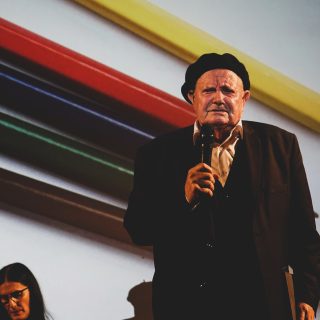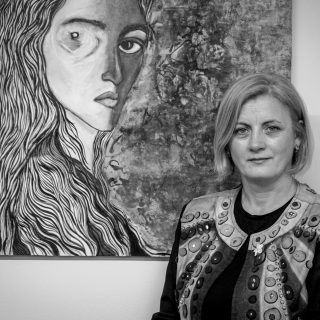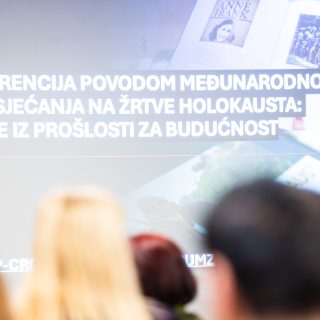Vjeran Pavlaković is a sociologist who edited the first book about culture of remembrance in the region. Born in Zagreb, he moved to USA when he was four years old. In the period from 1992 to 1996 he studied at the University of Arizona, where he graduated with a degree in history. In 1997 he moved to Seattle for his post-graduate studies and in 1999 he defended his master’s thesis at the Department of International Studies at the University of Washington. Working as an editor for Treagold Papers magazine and teaching his own courses, Pavlaković spent two years in Croatia researching a doctoral topic that dealt with political divisions in Croatia during the Spanish Civil War. He defended his doctoral dissertation at the University of Washington in June 2005 and worked as a research associate at the Woodrow Wilson International Center for Schoolars in Washington, D.C. Before he was employed at the Department of Cultural Studies at the University of Rijeka, he had a postdoctoral scholarship from the National Council for Eurasian and East European Research (NCEEER) in Croatia for two years.
You’ve been working on culture of remembrance in southeastern Europe for some time already. How did you become involved in that? What is so fascinating about it and why do you find it important?
When I was in Croatia from 2002-2004 on a Fulbright grant doing research on my PhD topic about Yugoslavs in the Spanish Civil War, I saw that the Croatian media was full of debates about World War 2 symbols, monuments, and commemorations, which I found surprising. It was a time when concerts of controversial singer Marko Perković Thompson were full of Ustaša symbolism, Tito’s statue in Kumrovec was blown up, and Bleiburg was a place where the radical right came to protest the International Criminal Tribunal for the former Yugoslavia’s (ICTY) indictment against General Ante Gotovina. Memory politics of WW2, communist Yugoslavia, and the Croatian War of Independence (Homeland War) were completely intertwined with everyday politics, so it was impossible not to get sucked into the debates. Although I was working on an earlier historical period, I could not help but ask myself why were memory politics playing such a big role in Croatian society at a time when the political elite should be focused on the future and European integration. I began to collect material for what would eventually be my post-doctoral project when I returned to Croatia in 2006, when I could focus on these issues fully. At that time memory studies were relatively unknown among local scholars, but there was nevertheless a lot of regional research beginning to take shape, such as the series of edited volumes published by Tihomir Cipek. Fifteen years later there have been many studies from various disciplines analyzing the various forms of remembrance cultures in the region, and it has shown that the emotional and symbolic power of wars, victims, and imagined glorious pasts are constantly used by mnemonic actors (political elites, associations, religious communities, and other social groups) for their own interests. For example, for two decades the main political parties in Croatia, HDZ and SDP, essentially had identical neoliberal economic and foreign policy platforms, but differed primarily on interpretations of WW2, which were highlighted to mobilize their voters. Prior to joining the EU, Croatia was under a lot of pressure from the ICTY and other international organizations to deal with the past, related to the 1990s but also issues of fascist symbols and communist crimes, so the public sphere was inundated with discussions of history. These debates were highly politicized and often sidelined professionally trained historians in favor of publicists and other media actors, which also revealed some deficiencies among Croatian historiography that had not kept up with global trends and theories.
Since you’ve lived in Arizona for quite a while, can you tell us about some differences and similarities in ways of commemorating and forming collective memories?
I lived in Arizona when I was in high school and college, but have been going back regularly ever since the 1990s. When you live in a place for a long time, it’s easy to overlook some aspects of history or politics that become apparent only when you move away and observe from a distance. I am currently working on a book about immigrants from Austrian Dalmatia to Tucson, Arizona, from 1880-1920, and this made me a lot more conscious of local memory politics, specifically what is remembered and what has been obliterated. Tucson is a UNESCO gastronomy heritage site because of 4000 years of continuous food production in the Santa Cruz River valley where the city is located, but much of the heritage of the indigenous peoples has been erased, commercialized, or pushed to reservations. The legacies of European (Spanish) colonialism and then American westward expansion was always celebrated positively, from Columbus Day to the monuments of the “Arizona pioneers” scattered around town. Arizona’s refusal to recognize Martin Luther King, Jr. Day in the late 1980s – early 1990s resulted in a national scandal, so unfortunately I would say that Arizona has had a bad reputation in the way it has dealt with the past. However, there are also positive signs that the marginalized histories are finally being recognized, at least symbolically. Murals and street art, which have a long tradition within the Hispanic community (especially since the Mexican Revolution when muralists like Diego Rivera became known across the globe), were for decades associated exclusively with vandalism and gang activity. In recent years, there has been an explosion of historical murals celebrating Tucson’s Hispanic heritage, its neighborhoods which were destroyed by rampant urban renewal, and important figures from Tucson’s past that were forgotten in the city’s rapid expansion since the middle of the twentieth century. New monuments by indigenous and Hispanic artists mark the first contact between indigenous peoples and Europeans, as well as mourn the loss of important historical areas such as Barrio Viejo. The University of Arizona, one of Tucson’s most important institutions, implemented a land acknowledgment statement recognizing that the university is located on land that had once been home to the Tohono O’Odham and Yaqui tribes. These might seem like small steps, but they all help show that this borderland state has a much more layered and complex history beyond the myths of the Wild West and Manifest Destiny.
Did you stumble upon any bureaucratic or some other kind of problems in your work on remembrance culture and ways of commemorating events that are important for the history and the directing of a collective identity?
That is a very interesting question and an important one for anyone interested in researching memory politics. I think I was lucky in the early years of my fieldwork in that no one was expecting obscure commemorations or isolated monuments to be the subject of scientific analysis, so I could freely move around as any of the other “official” participants. This included gaining full access with the political elite at commemorations of Operation Storm in Knin or the Vukovar memory procession without any kind of accreditation. Now these commemorations are more official and highly controlled. During my project FRAMNAT for the Croatian Science Foundation (HRZZ) we were able to get official passes for all of the events without any problem. There have been some awkward situations during fieldwork however. During a commemoration in Bleiburg, Austria, several years ago, some right-wing participants yelled at me when I was giving an interview to Austrian television, and in Derventa, Bosnia-Herzegovina, I was taken in for questioning when photographing a monument in front of a police station. I always found it paradoxical that participants at right-wing or nationalist commemorations are in some way ashamed of the symbols they show, as if knowing that what they are doing is unacceptable yet still denying that it should be banned. I have spoken to several journalists that have also been attacked and threatened at the Bleiburg commemoration. But in general my strategy is to try to fit in and observe, and listen to what people have to say rather than engage in ideological arguments.
You’re often working on various projects; can you tell us about some recent research and projects you’ve been working on?
One very exciting and dynamic project that is wrapping up is Rijeka/Fiume in Flux, led by Brigitte Le Normand (Maastricht University). It involved creating an app of various sites of memory in Rijeka, ones that are still there and others that have disappeared over the course of the turbulent 20th century, like the monument to King Aleksandar Karađorđević that once stood in front of today’s University of Rijeka rectorate, or the memorial to Rijeka’s pro-Italian forces that used to be on the Riva. This app (https://rijekafiumeinflux.com/en/home/) offers curated tours through Rijeka that is of interest not only to visitors to Rijeka, but also locals and researchers who want to learn more about the city’s memoryscape. I am also participating in a European networking project called COST Action “Slow Memory”, which brings together scholars from over 30 countries to discuss various approaches to the concept of slowness in memory studies. This includes the memory of climate change and environmental crises to remembrance beyond events or processes. As I mentioned earlier, battles, heroes, and victims from the conflicts in the former Yugoslavia provide elites with fertile ground for symbolic memory politics that in many ways keep our societies locked into the past, whereas we are investigating processes that are slower, such as the long spans of cooperation in the region or even the peace process which is not tied to a dramatic event. Part of my contribution is looking at the historical murals in Arizona which help visualize and ultimately remember the many groups that have been marginalized and forgotten in state’s rapid modernization. Finally, the Department of Cultural Studies is excited to host Jeremy Walton’s ERC project “Revenant”, which deals with memory and amnesia of the Habsburg, Ottoman, and Russian empires that have influenced and left their traces across Southeastern Europe. Revenant’s research group will certainly inspire lots of collaboration, discussions, and opportunities for both scholars and students at the University of Rijeka, and will build upon many of the projects and ideas my colleagues and I have been working on over the past decade.
You also try to connect and compare the ways of commemorating in southeastern Europe with some other parts of the world, like Germany. Can you tell us more about your collaboration with the University of Regensburg?
The University of Regensburg and the Leibniz Center for Eastern and Southeastern Europe (IOS) have been partners with the University of Rijeka for many years, and I have worked extensively with a number of excellent professors and students there, organizing excursions, conferences, exchanges, and project proposals. A number of students from Regensburg have attended courses in Rijeka via Erasmus, and since 2020 we have had a regular online series of presentations titled Regensburg & Rijeka Lecture series to exchange recent research results. Regensburg was recently awarded a large grant from the Volkswagen Stiftung to set up a new program, A small but fertile field: Strengthening Southeast European Studies in Regensburg (https://seeffield.app.uni-regensburg.de/), with various partners across the region including the University of Rijeka. This program will continue some of the activities we have already been engaged with, such as conferences, workshops, and student exchanges, but will also expand to hopefully include teaching collaboration and funding for post-doc projects and similar research activities. Regensburg is also developing a research center for memory studies, centered around the nearby Flossenbürg Concentration Camp Memorial Museum, which offers a rich case study for understanding how a society deals with the past, from denial to official memorialization. Finally, I am currently a visiting fellow in Regensburg, in part associated with the Regensburg Leibniz Science Campus “Europe and America in the Modern World: Transformations and Frictions of Globality in Past and Present”, where I have had the opportunity to work on my research of Southeastern European immigrants in Tucson. As you can see, there are many mechanisms and opportunities for cooperation, from memory studies to Southeastern European studies more broadly, and I think this collaboration has benefited not only scholars but students and young researchers who can take advantage of this transnational exchange.
Interview conducted and edited by: Monika Jurić
Monika Jurić was born in Pula in 1999., where she also attended both high school specialised in languages, and music school. She is a student of culturology on the Faculty of Humanities and Social Sciences in Rijeka where she, thanks to professor Pavlaković, developed an interest in remembrance culture in the second year of her studies. She deals with public relations for a few organisations and volunteers as a journalist. In her work, she tries to raise awarness about the problems from the past that are still relevant and about the importance of popular culture and art as a reflection of social, political and economic problems. Currently, she is writing her MA thesis on the interrelationship of fashion, politics and economics in globalized world, in which she will present a circular repetition of fashion trends that historically follow economic trends and political changes.




